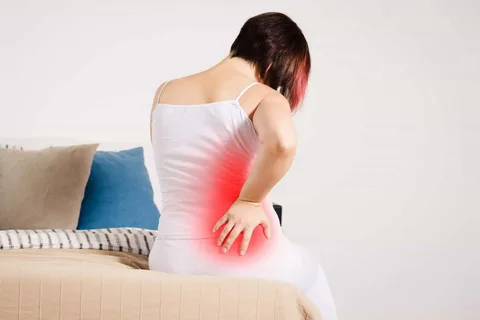What Causes Left Lower Back Pain in Females

Left lower back pain is one of the most common health complaints among women. It can range from mild discomfort to severe pain that disrupts daily life and limits mobility. The causes can vary widely—from musculoskeletal issues to internal organ problems. Understanding the source of this discomfort is the first step toward finding effective relief and preventing it from returning.
For many women, lower back pain develops from muscle strains, hormonal fluctuations, or structural issues in the spine. Others may experience pain linked to reproductive or urinary system conditions. Because there are many potential causes, accurate diagnosis and personalized treatment are vital to recovery.
Common Musculoskeletal Causes of Left Lower Back Pain
Muscle strain remains one of the most frequent reasons women experience left lower back pain. This happens when the muscles or soft tissues supporting the spine become overstretched due to sudden movements, heavy lifting, or repetitive physical activity. Tight muscles can limit flexibility, leading to stiffness and ongoing discomfort.
Women who spend long periods sitting at a desk or standing without proper support are at higher risk of developing chronic lower back pain. Poor posture places extra pressure on the lumbar spine and surrounding soft tissues, which can worsen over time. Physical therapy, stretching, and ergonomic adjustments often help reduce pain and restore strength.
Spinal Issues That Cause Pain
Several spinal conditions can lead to sharp pain or persistent lower back discomfort on the left side. A herniated disc occurs when one of the spinal discs between the vertebrae ruptures or bulges, pressing against nearby spinal nerves. This pressure can cause radiating pain that spreads down one or both legs, often described as sciatic nerve pain.
Spinal stenosis, another common cause, happens when the spinal canal narrows and compresses the spinal cord or spinal nerves. Women with spinal stenosis may experience leg pain, numbness, or weakness. Degenerative conditions like osteoarthritis can also contribute to chronic pain by breaking down cartilage and affecting joint mobility in the spinal column.
These spinal problems often develop gradually, particularly in women over forty. A medical evaluation including physical exams and imaging tests like MRI or CT scans can help identify the exact source of pain and guide the right treatment plan.
Gynecological and Hormonal Factors
Pain in the left lower back may sometimes be linked to reproductive organs. Hormonal changes during the menstrual cycle can cause inflammation or cramping that radiates to the lower back or pelvis. Conditions like ovarian cysts or endometriosis can also trigger pain that feels similar to musculoskeletal discomfort but stems from deeper internal tissues.
Endometriosis involves tissue similar to the lining of the uterus growing outside of it, causing inflammation, scar tissue, and severe pelvic pain. This discomfort often intensifies during menstruation and can affect one or both sides of the lower back.
Ovarian cysts may produce pressure or a sharp pain in the left lower abdomen and back, especially if the cyst ruptures or grows larger. A gynecological exam, ultrasound, or blood tests can help determine if reproductive health issues are behind the symptoms.
Kidney and Urinary Tract Conditions
Kidney problems often cause left-sided back pain that is dull or aching in nature. Kidney stones can produce sudden, sharp pain that radiates from the back to the lower abdomen and groin. When the stone moves through the urinary tract, pain may come in waves and vary in intensity.
A kidney infection (pyelonephritis) can also result in back pain, along with fever, chills, or frequent urination. Infections require medical attention, as untreated kidney issues can lead to more serious health complications. Drinking enough water, maintaining good hygiene, and seeking prompt care for urinary symptoms can help prevent future problems.
Digestive and Bowel-Related Causes
Sometimes, lower back pain in females can be related to the digestive system. Conditions such as constipation, irritable bowel syndrome (IBS), or bowel dysfunction may create discomfort that spreads to the lower back. The muscles and nerves in the abdominal area are closely connected to the lumbar spine, so digestive distress can indirectly cause tension and pain.
Inflammatory bowel diseases like Crohn’s disease or ulcerative colitis may also trigger back pain, particularly when inflammation affects nearby nerves or tissues. A proper medical history and dietary evaluation are necessary to find the underlying cause.
Pregnancy-Related Back Pain
Pregnancy introduces several changes that can lead to back pain on the left side. As the uterus expands, it shifts the body’s center of gravity, putting additional pressure on the lumbar spine and pelvic joints. Hormonal changes loosen ligaments, which can reduce stability in the spinal bones and soft tissues.
Many expectant mothers report back discomfort starting in the second trimester. Gentle exercise, stretching, and prenatal physical therapy help strengthen the muscles that support the back. Good posture and supportive shoes also reduce strain.
When to Seek Medical Attention
Although most cases of left lower back pain resolve with rest and simple treatments, persistent or severe pain should not be ignored. If pain affects daily life or is accompanied by symptoms such as numbness, leg weakness, fever, or loss of bladder or bowel control, immediate medical attention is needed.
A healthcare provider can evaluate symptoms through a detailed medical history, physical exam, and imaging tests. The diagnosis determines whether the cause is musculoskeletal, neurological, or related to internal organs. Early diagnosis allows for a treatment plan that prevents the pain from becoming chronic.
Treatment Options for Left Lower Back Pain
Treatment varies depending on the root cause. For mild muscle strains, over the counter pain relievers, ice packs, and rest can reduce inflammation and soreness. Stretching and strengthening exercises supervised by a physical therapist help restore mobility and prevent future injury.
For spinal issues such as herniated discs or spinal stenosis, physical therapy, chiropractic care, and prescription medications may relieve pressure and improve posture. In severe cases, nerve blocks or surgical procedures may be considered to correct structural problems and relieve pain.
If kidney stones or infections are the cause, medical treatment may include antibiotics or procedures to remove stones. Women with hormonal or reproductive conditions may need hormone therapy or minimally invasive procedures to address the underlying issue.
Lifestyle adjustments also play a key role. Maintaining a healthy weight, engaging in regular physical activity, and improving posture all reduce pressure on the lower back. Managing stress through yoga or relaxation techniques may also help reduce muscle tension.
Preventing Future Back Pain
Preventing lower back pain begins with building core strength and keeping the spine properly aligned. Avoiding prolonged sitting, especially without back support, can prevent stiffness. Women who work at desks should adjust their chairs and computer screens to maintain good posture.
Regular exercise improves blood flow and keeps muscles flexible, reducing the risk of tightness and spasms. Staying hydrated, eating a balanced diet, and taking breaks during physical work can also help keep the back healthy.
It’s important to listen to the body. Pain signals that something needs attention. Addressing minor discomfort early can prevent more serious complications later.
Final Thoughts
Left lower back pain in females can stem from a wide range of causes, from simple muscle strain to complex internal conditions. Identifying the root cause is the most important step toward relief and long-term recovery. Whether the pain originates from the spine, muscles, kidneys, or reproductive system, a customized treatment plan helps restore balance and comfort.
For expert diagnosis and comprehensive care, visit Serenoa Vitality. Their team of professionals combines medical expertise with personalized care to help women manage lower back pain effectively and improve overall well-being.
Read More Blogs!
Stay updated with the latest blog posts and engage with our community.
What You Get With Us
Wellness and Chiropractic care as it should be. At Serenoa Vitality & Wellness, we care about and get to know each of our patients. It's like having a doctor in the family.
From spinal adjustments to functional wellness, we offer a comprehensive suite of services designed to support lasting health and vitality.

